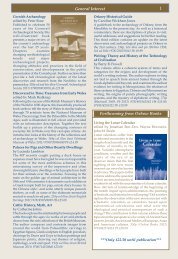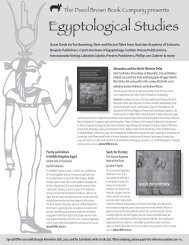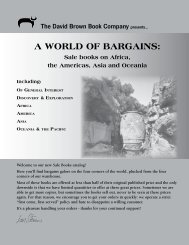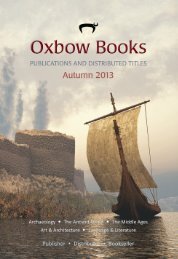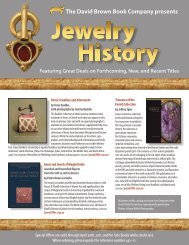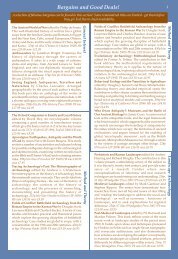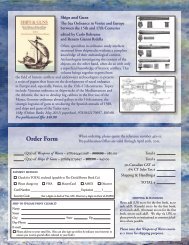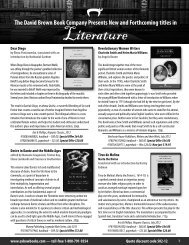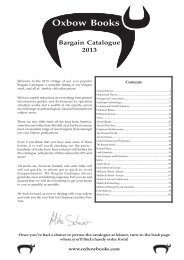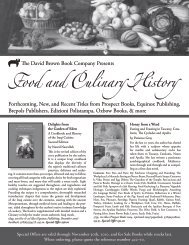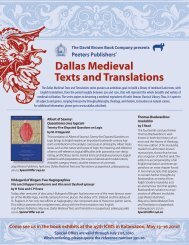Oxbow Spring 2013.pdf - Oxbow Books
Oxbow Spring 2013.pdf - Oxbow Books
Oxbow Spring 2013.pdf - Oxbow Books
Create successful ePaper yourself
Turn your PDF publications into a flip-book with our unique Google optimized e-Paper software.
Bones for Tools – Tools for Bones<br />
The Interplay Between Objects and Objectives<br />
Krish Seetah (Editor); Brad Gravina (Editor)<br />
Animal procurement and tool production form two of the most tightly connected<br />
components of human behaviour. The interaction between these fundamental<br />
activities has been a subject of archaeological inference from the earliest days<br />
of the discipline, yet the pursuit of each has tended to encourage and entrench<br />
specialist study. This volume begins the process of integrating what have all too<br />
often become isolated archaeological and interpretative domains. In taking a<br />
more inclusive approach to the material, technological and social dynamics of<br />
early human subsistence we have returned to the earliest of those archaeological<br />
associations: that between stone tools and animal bones. In revealing the interdependence<br />
of their relationship, this volume takes what we hope will be a<br />
first step towards a revitalized understanding of the scope of past interactions<br />
between humans and the world around them.<br />
9781902937595, £45.00, January 2013<br />
HB, 164p, 99 b/w figs, 26 tables, McDonald Institute for Archaeological Research<br />
Preserving Archaeological Remains in Situ<br />
Proceedings of the 4th International Conference<br />
David Gregory (Editor); Henning Matthiesen (Editor)<br />
The PARIS 4 conference, which took place at the National Museum of Denmark<br />
in 2011, attracted over 100 participants from 18 countries. Delegates presented<br />
and discussed the latest developments in the field of Preserving Archaeological<br />
Remains In Situ. These proceedings explore four major themes: rates of<br />
degradation in archaeological remains and the limits of acceptable change;<br />
the techniques and duration of monitoring on archaeological sites; the role of<br />
multinational standards when the sites and national legislations are so variable;<br />
reviewing the effectiveness of in situ preservation, after nearly two decades of<br />
research.<br />
9781907975875, £55.00, Available Now,<br />
HB, 489p, Conservation and Management of Archaeological Sites Special Issue, Maney Publishing<br />
The Value of an Archaeological Open-Air Museum is in its Use<br />
Understanding Archaeological Open-Air Museums and their Visitors<br />
Roeland Paardekooper (Author)<br />
There are about 300 archaeological open-air museums in Europe. Their history<br />
goes from Romanticism up to modern-day tourism. With the majority dating to<br />
the past 30 years, they do more than simply present (re)constructed outdoor<br />
sceneries based on archaeology. They have an important role as educational<br />
facilities and many showcase archaeology in a variety of ways. Compared to<br />
other museum categories, archaeological open-air museums boast a wide variety<br />
of manifestations. This research assesses the value of archaeological open-air<br />
museums, their management and their visitors, and is the first to do so in such<br />
breadth and detail. After a literature study and general data collection among<br />
199 of such museums in Europe, eight archaeological open-air museums from<br />
different countries were selected as case studies including both public and<br />
privately funded examples.<br />
9789088901034, £35.00, Available Now<br />
PB, 300p, 210 x 280 mm, 109 col & 29 b/w illus., Sidestone Press<br />
5Method and Theory




